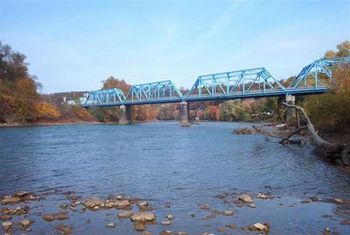Kiskiminetas River facts for kids
Quick facts for kids Kiskiminetas River |
|
|---|---|

View across the Kiskiminetas River, looking downstream from the shoreline along Leechburg, Pennsylvania
|
|
|
Location of the mouth of the Kiskiminetas River in Pennsylvania
|
|
| Country | United States |
| State | Pennsylvania |
| Physical characteristics | |
| Main source | Confluence of Conemaugh River and Loyalhanna Creek Saltsburg, Pennsylvania 827 feet (252 m) 40°29′8″N 79°27′14″W / 40.48556°N 79.45389°W |
| River mouth | Allegheny River Schenley, Pennsylvania 745 ft (227 m) 40°40′46″N 79°40′1″W / 40.67944°N 79.66694°W |
| Length | 27 mi (43 km) |
| Basin features | |
| River system | Allegheny River |
| Tributaries |
|
The Kiskiminetas River is a cool river in Western Pennsylvania, United States. People who live nearby often call it the Kiski. It's about 27 miles (43 km) long. The Kiski River flows into the Allegheny River, which is a much bigger river. The area around these rivers is sometimes called the Alle-Kiski Valley.
Contents
Journey of the Kiski River
The Kiskiminetas River starts in a town called Saltsburg. This is where two other rivers, the Conemaugh River and Loyalhanna Creek, meet up. Imagine two streams joining to form a new, bigger river!
From Saltsburg, the Kiski River winds its way northwest. It flows past several towns like Avonmore, Apollo, Vandergrift, Hyde Park, and Leechburg. Finally, it joins the Allegheny River near Freeport at a place called Schenley. This spot is about 25 miles (40 km) northeast of a big city called Pittsburgh.
The land around the Kiski River, known as the Kiski-Conemaugh watershed, was once a very important area for digging up coal. Because of this, the water in the river and its smaller streams has faced some challenges. Many old mines left behind polluted water. But don't worry, people are working hard to clean up the river and make its water healthy again!
Long ago, Native Americans and early European settlers used a major trail called the Kittanning Path. This path crossed the Kiski River at a shallow spot near where Leechburg is today.
Towns and Areas Along the River
As the Kiskiminetas River flows, it passes through different towns and areas. Here are some of them, listed in order from where the river starts to where it ends:
- Saltsburg
- Loyalhanna Township, Westmoreland County
- Conemaugh Township, Indiana County
- Kiskiminetas Township, Armstrong County
- Bell Township, Westmoreland County
- Allegheny Township, Westmoreland County
- Parks Township, Armstrong County
- Leechburg
- Gilpin Township, Armstrong County
Smaller Rivers Joining the Kiski
Many smaller streams and creeks flow into the Kiskiminetas River. These are called tributaries. They add water to the Kiski as it makes its way to the Allegheny River.
Here are some of the main tributaries of the Kiskiminetas River:
- Elder Run
- Penn Run
- Brady Run
- Guffy Run
- Carnahan Run
- Pine Run
- Beaver Run
- Roaring Run (which also has a smaller stream called Rattling Run)
- Flat Run
- Wolford Run
- Long Run
- Sulphur Run
- Blacklegs Creek (which has its own smaller streams like Big Run, Marshall Run, Harpers Run, Nesbit Run, Hooper Run, and Whisky Run)
- Loyalhanna Creek
- Conemaugh River
What Does "Kiskiminetas" Mean?
The name "Kiskiminetas" is pretty unique, and its exact meaning isn't perfectly clear! It likely comes from a Native American language.
Some people think it means "Place of the largest stream." Others believe it could mean "river of the big fish" or even "plenty of walnuts."
One historian, John Heckewelder, who wrote about Native American tribes long ago, thought the name came from a word meaning "make daylight." He thought it might have been a command given by a warrior to start moving at dawn.
Another idea is that it means "cut spirit." And finally, some believe "Kiskiminetas" means "clear, clean stream of many bends." It's cool to think about how many different meanings one name can have!


